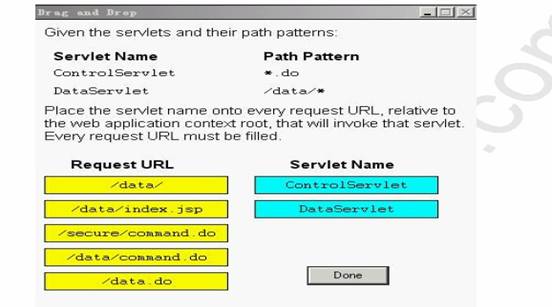Page: 5
2. The Structure and Deployment of Web Applications
Q 20. Which path is required to be present within a WAR file?
A. /classes B. /index.html
C. /MANIFEST-INF D. /WEB-INF/web.xml
E. /WEB-INF/classes F. /WEB-INF/index.html
G. /META-INF/index.xml
Answer: D
Q21. Given:
11. <servlet>
12. <servlet-name>catalog</servlet-name>
13. <jsp-file>/catalogTemplate.jsp</jsp-file>
14. <load-on-startup>10</load-on-startup>
15. </servlet>
Which two are true? (Choose two.)
A. Line 13 is not valid for a servlet declaration.
B. Line 14 is not valid for a servlet declaration.
C. One instance of the servlet will be loaded at startup.
D. Ten instances of the servlet will be loaded at startup.
E. The servlet will be referenced by the name catalog in mappings.
Answer: C, E
Q22. You have built a web application with tight security. Several directories of your webapp are used for internal purposes and you have overridden the default servlet to send an HTTP 403 status code for any request that maps to one of these directories. During testing, the Quality Assurance director decided that they did NOT like seeing the bare response page generated by Firefox and Internet Explorer. The director recommended that the webapp should return a more user-friendly web page that has the same look-and-feel as the webapp plus links to the webapp's search engine. You have created this JSP page in the /WEB-INF/jsps/error403.jsp file. You do NOT want to alter the complex logic of the default servlet. How can you declare that the web container must send this JSP page whenever a 403 status is generated?
A. <error-page>
<error-code>403</error-code>
<url>/WEB-INF/jsps/error403.jsp</url>
</error-page>
B. <error-page>
<status-code>403</status-code>
<url>/WEB-INF/jsps/error403.jsp</url>
</error-page>
C. <error-page>
<error-code>403</error-code>
<location>/WEB-INF/jsps/error403.jsp</location>
</error-page>
D. <error-page>
<status-code>403</status-code>
<location>/WEB-INF/jsps/error403.jsp</location>
</error-page>
Answer: C
Q23. Given a portion of a valid Java EE web application's directory structure:
MyApp
|
|-- Directory1
| |-- File1.html
|
|-- META-INF
| |-- File2.html
|
|-- WEB-INF
|-- File3.html
You want to know whether File1.html, File2.html, and/or File3.html is protected from direct access by your web client's browsers.
What statement is true?
A. All three files are directly accessible.
B. Only File1.html is directly accessible.
C. Only File2.html is directly accessible.
D. Only File3.html is directly accessible.
E. Only File1.html and File2.html are directly accessible.
F. Only File1.html and File3.html are directly accessible.
G. Only File2.html and File3.html are directly accessible.
Answer: B
Q24. A web component accesses a local EJB session bean with a component interface of com.example.Account with a home interface of com.example.AccountHome and a JNDI reference of ejb/Account. Which makes the local EJB component accessible to the web components in the
web application deployment descriptor?
A. <env-ref>
<ejb-ref-name>ejb/Account</ejb-ref-name>
<ejb-ref-type>Session</ejb-ref-type>
<local-home>com.example.AccountHome</local-home>
<local>com.example.Account</local>
</env-ref>
B. <resource-ref>
<ejb-ref-name>ejb/Account</ejb-ref-name>
<ejb-ref-type>Session</ejb-ref-type>
<local-home>com.example.AccountHome</local-home>
<local>com.example.Account</local>
</resource-ref>
C. <ejb-local-ref>
<ejb-ref-name>ejb/Account</ejb-ref-name>
<ejb-ref-type>Session</ejb-ref-type>
<local-home>com.example.AccountHome</local-home>
<local>com.example.Account</local>
</ejb-local-ref>
D. <ejb-remote-ref>
<ejb-ref-name>ejb/Account</ejb-ref-name>
<ejb-ref-type>Session</ejb-ref-type>
<local-home>com.example.AccountHome</local-home>
<local>com.example.Account</local>
</ejb-remote-ref>
Answer: C
Q 25. Click the Task button.
Place the servlet name onto every request URL, relative to the web application context root, that will invoke that servlet. Every request URL must be filled.

Answers:
Q26. Given a portion of a valid Java EE web application's directory structure:
MyApp
|
|-- File1.html
|
|-- Directory1
| |-- File2.html |
|-- META-INF
|-- File3.html
You want to know whether File1.html, File2.html, and/or File3.html will be directly accessible by your web client's browsers.
Which statement is true?
A. All three files are directly accessible. B. Only File1.html is directly accessible.
C. Only File2.html is directly accessible. D. Only File3.html is directly accessible.
E. Only File1.html and File2.html are directly accessible.
F. Only File1.html and File3.html are directly accessible.
G. Only File2.html and File3.html are directly accessible.
Answer: E
Page: 5
1
2
3
4
5
6